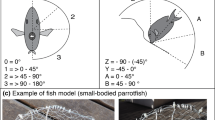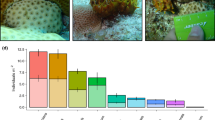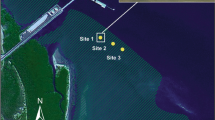Abstract
Recent studies have emphasized the role of positive interactions in ecological communities, but few have addressed how positive interactions are mediated by abiotic stress and biotic interactions. Here, I investigate the effect of a facilitator species on the abundance of macroalgae over a gradient of herbivory. Grazing by sea urchins can be intense on temperate reefs along the California coast, with benthic macroalgae growing exclusively in physical refuges and interspersed within colonies of the strawberry anemone, Corynactis californica. Field experiments indicated that the net effect of C. californica on turf algae was strongly nonlinear over a gradient in density of sea urchins. At low intensities of urchin grazing, the anemone and macroalgae competed for space, with algae capable of overgrowing C. californica. At intermediate grazing intensities, C. californica provided a refuge for turf algae but not for juvenile kelp. Neither turf algae nor kelp benefited from the presence of C. californica at the highest levels of grazing intensity, as sea urchins consumed nearly all macroalgae. The hump-shaped effect observed for C. californica contrasts with the prevailing view in ecological theory that positive interactions are more common in harsh environmental conditions. The results reported here qualify this view and underscore the need to evaluate positive interactions over a range of abiotic stress and consumer pressure.






Similar content being viewed by others
References
Atsatt PR, O’Dowd DJ (1976) Plant defense guilds. Science 193:24–29
Bertness MD, Callaway R (1994) Positive interactions in communities. Trends Ecol Evol 9:191–193
Bertness MD, Shumway S (1993) Competition and facilitation in marsh plants. Am Nat 142:718–724
Bertness MD, Leonard GH, Levine JM, Schmidt PR, Ingraham AO (1999) Testing the relative contribution of positive and negative interactions in rocky intertidal communities. Ecology 80:2711–2726
Brooker RW, Callaghan TV (1998) The balance between positive and negative plant interactions and its relationship to environmental gradients: a model. Oikos 81:196–207
Brooker RW, Scott D, Palmer SCF, Swaine E (2006) Transient facilitative effects of heather on Scots pine along a grazing disturbance gradient in Scottish moorland. J Ecol 94:637–645
Bruno JF, Stachowicz JJ, Bertness MD (2003) Inclusion of facilitation into ecological theory. Trends Ecol Evol 18:119–125
Callaway R (1998) Competition and facilitation on elevation gradients in subalpine forests of the northern Rocky Mountains, USA. Oikos 82:561–573
Callaway R, Walker L (1997) Competition and facilitation: a synthetic approach to interactions in plant communities. Ecology 78:1958–1965
Callaway RM, Brooker RW, Choler P, Kikvidze Z, Lortie CJ, Michalet R, Paolin L, Pugnaire FI, Newingham B, Aschehoug ET, Armas C, Kikodze D, Cook BJ (2002) Positive interactions among alpine plants increase with stress. Nature 417:844–848
Callaway RM, Kikodze D, Chiboshvili M, Khetsuriani L (2005) Unpalatable plants protect neighbors from grazing and increase plant community diversity. Ecology 86:1856–1862
Chadwick N (1987) Interspecific aggressive behavior of the corallimorpharian Corynactis californica (cnidaria: anthozoa) effects on sympatric corals and sea anemones. Biol Bull 173:110–125
Chadwick NE, Adams C (1991) Locomotion, asexual reproduction, and killing of corals by the corallimorpharian Corynactis californica. Hydrobiologia 216:263–269
Coley PD, Barone JA (1996) Herbivory and plant defenses in tropical forests. Annu Rev Ecol Syst 27:305–335
Coyer JA, Ambrose RF, Engle JM, Carroll JC (1993) Interactions between corals and algae on a temperate zone rocky reef—mediation by sea urchins. J Exp Mar Biol Ecol 167:21–37
Dungan ML (1986) Three-way interactions—barnacles, limpets, and algae in a Sonoran desert rocky intertidal zone. Am Nat 127:292–316
Ebeling AW, Laur DR, Rowley RJ (1985) Severe storm disturbances and reversal of community structure in a southern California kelp forest. Mar Biol 84:287–294
Gaylord B, Reed DC, Washburn L, Raimondi PT (2004) Physical–biological coupling in spore dispersal of kelp forest macroalgae. J Mar Syst 49:19–39
Greenlee J, Callaway R (1996) Abiotic stress and the relative importance of interference and facilitation in montane bunchgrass communities in western Montana. Am Nat 148:386–396
Hacker SD, Gaines SD (1996) Trophic consequences of a positive plant interaction. Am Nat 148:559–575
Hacker SD, Gaines SD (1997) Some implications of direct positive interactions for community species diversity. Ecology 78:1990–2003
Hairston NG, Smith FE, Slobodkin LB (1960) Community structure, population control, and competition. Am Nat 94:421–425
Harrold C, Pearse J (1987) The ecological role of echinoderms in kelp forests. In: Jangoux M, Lawrence JM (eds) Echinoderm studies II. Balkema, Rotterdam, pp 137–233
Hay ME (1986) Associational plant defenses and the maintenance of species diversity: turning competitors into accomplices. Am Nat 128:617–641
Hay ME, Steinberg PD (1992) The chemical ecology of plant–herbivore interactions in marine versus terrestrial communities. In: Rosenthal J, Berenbaum M (eds) Herbivores: their interaction with secondary metabolites, evolutionary and ecological processes. Academic, San Diego, pp 371–413
Holts LJ, Beauchamp KA (1993) Sexual reproduction in the corallimorpharian sea anemone Corynactis californica in a central California kelp forest. Mar Biol 116:129–136
Kushner DJ, Lerma D, Donahue M (2001) Kelp forest monitoring, 2000 annual report. Channel Islands National Park, Ventura
Lawrence JM (1975) On the relationships between marine plants and sea urchins. Oceanogr Mar Biol 13:213–286
Levenbach S (2008a) Behavioral mechanism for an associational refuge for macroalgae on temperate reefs. Mar Ecol Prog Series (in press)
Levenbach S (2008b) Community-wide ramifications of an associational refuge on shallow rocky reefs. Ecology (in press)
Levine JM (2000) Complex interactions in a streamside plant community. Ecology 81:3431–3444
Maestre F, Cortina J (2004) Do positive interactions increase with abiotic stress? A test from a semi-arid steppe. Proc R Soc Lond B Biol 271:S331–S333
Maestre F, Valladares F, Reynolds J (2005) Is the change of plant–plant interactions with abiotic stress predictable? A meta-analysis of field results in arid environments. J Ecol 93:748–757
Mauricio R (2000) Natural selection and the joint evolution of tolerance and resistance as plant defenses. Evol Ecol 14:491–507
Olff H, Ritchie ME (1998) Effects of herbivores on grassland plant diversity. Trends Ecol Evol 13:261–265
Olff H, Vera FWM, Bokdam J, Bakker ES, Gleichman JM, de Maeyer K, Smit R (1999) Shifting mosaics in grazed woodlands driven by the alternation of plant facilitation and competition. Plant Biol 1:127–137
Paine RT (1974) Intertidal community structure: experimental studies on the relationship between a dominant competitor and its principal predator. Oecologia 15:93–120
Patton ML, Brown ST, Harman RF, Grove RS (1991) Effect of the anemone Corynactis californica on subtidal predation by sea stars in the southern California bight. Bull Mar Sci 48:623–634
Pennings S, Selig E, Houser L, Bertness M (2003) Geographic variation in positive and negative interactions among salt marsh plants. Ecology 84:1527–1538
Pfister CA, Hay ME (1988) Associational plant refuges—convergent patterns in marine and terrestrial communities result from differing mechanisms. Oecologia 77:118–129
Rebollo S, Milchunas DG, Noy-Meir I, Chapman PL (2002) The role of a spiny plant refuge in structuring grazed shortgrass steppe plant communities. Oikos 98:53–64
Reed DC, Foster MS (1984) The effects of canopy shading on algal recruitment and growth in a giant kelp forest. Ecology 65:937–948
Rosenthal JP, Kotanen PM (1994) Terrestrial plant tolerance to herbivory. Trends Ecol Evol 9:145–148
Russell M (1987) Life history traits and resource allocation in the purple sea urchin Strongylocentrotus purpuratus (Stimpson). J Exp Mar Biol Ecol 108:199–216
Skaer RJ, Picken ER (1965) The structure of the nematocyst thread and the geometry of discharge in Corynactis viridis Allman. Phil Trans R Soc B 250:131–164
Stachowicz JJ, Hay ME (1999) Reducing predation through chemically mediated camouflage: indirect effects of plant defenses on herbivores. Ecology 80:495–509
Travis JMJ, Brooker RW, Clark EJ, Dytham C (2006) The distribution of positive and negative species interactions across environmental gradients on a dual-lattice model. J Theor Biol 241:896–902
Vadas RL, Elner RW, Garwood PE, Babb IG (1986) Experimental evaluation of aggregation behavior in the sea urchin Strongylocentrotus droebachiensis—a reinterpretation. Mar Biol 90:433–448
Acknowledgments
The field work would not have been possible without the following dedicated volunteer divers: M. Beritzhoff, M. Cabanne, A. Craig, Q. Do, J.M. Ecker, R. Fisher, C. Kane, M. Kay, S. Lucato, C. Pierre, A. Parsons-Field, B. Pitterle, J. Phillips, A. Ray, M. Saxter, C. Simpson, C. Smith, J. Sprague, S. Thomas–Bignami, T. Welche, and lab assistants D. Combs and L. Levenbach. This research benefited from conversations with K. Arkema, A. Brooks, T. Even, H. Lenihan, S. Holbrook, S. Murawski, A. Rassweiler, D. Reed, and R. Schmitt. Special thanks go to the generous financial and logistical support from the Santa Barbara Coastal LTER (NSF grant no. OCE-9982105), and the Nuevo Energy Company for access to oil platforms. This research was also supported by graduate student fellowships from the University of California Toxic Substances and Teaching Program, the University of California Marine Council’s Coastal Environmental Quality Initiative, UCSB Affiliates Graduate Dissertation Fellowship, and a Regent’s Fellowship from the University of California at Santa Barbara. The experiments complied with the current laws of the country in which they were performed.
Author information
Authors and Affiliations
Corresponding author
Additional information
Communicated by Marc Mangel.
Rights and permissions
About this article
Cite this article
Levenbach, S. Grazing intensity influences the strength of an associational refuge on temperate reefs. Oecologia 159, 181–190 (2009). https://doi.org/10.1007/s00442-008-1186-8
Received:
Accepted:
Published:
Issue Date:
DOI: https://doi.org/10.1007/s00442-008-1186-8




